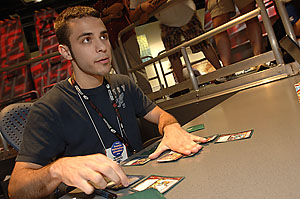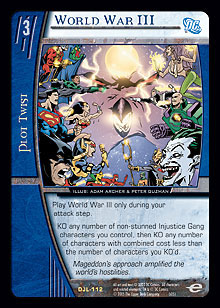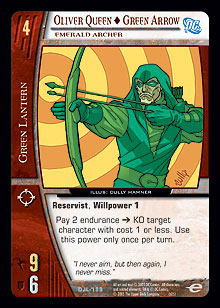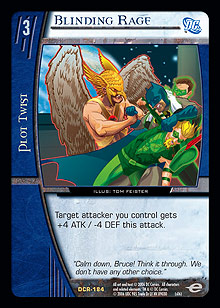
Howdy, loyal readers! I’m glad you decided to drop by this week and take a gander at what I have to offer. This week will be a very humbling experience for me. As you read last week, I gave you an in-depth review of the Pro Circuit Indianapolis festivities, from the event itself to the inaugural Team $10K. Now, I am going to swallow my pride and show you the testing process that Team Alternate Win Condition engaged in (which, unfortunately, I didn’t have enough faith in). Hopefully, by going through all the ins and outs of our testing process, we can both learn a little bit about trusting our instincts and results.
Gamers Don’t Make Mistakes, They Take Bad Beats . . . Right?
I was required to submit two articles in one week due to my wedding and honeymoon, so last night I was sitting with my good friend Tim Batow discussing what in the world I could write this article about. Right now, I am likely basking in the sweet, sweet Acapulco sun sipping a margarita, strawberry daiquiri, or some other fruity drink that will no doubt make you question my masculinity. But who cares, I’m married!
 Anyway, we began to talk about what we like most about the Vs. community in general. I mentioned the fact that almost everyone I meet is a high-quality individual who will take the time to say hey and talk some strategy. Tim lamented fondly how professional most of his opponents were. And I said, yeah, this doesn’t help me much. Tim then had a stroke of genius. He quickly suggested that I could write about the testing process for the Good Guys deck that we took to the Pro Circuit. He then just as quickly bit his tongue as his memory flashed to my disappointed look when I told him I’d been forced to drop out of the PC. But he was on to something. How often do you see a pro player admit a mistake? Not just a small mistake, but a massive mistake that potentially cost him or her (and his or her teammates, via team splits) an undetermined amount of money? Not very often. Most card games are riddled with bad beat stories and frustrated players lamenting for one more turn; I’m here today to help buck that system. I have some valuable information to impart, and in order to do it, I must own up. I made a massive mistake. I took a deck that, while not awful, was not the best deck available and went against what my teammates considered to be the optimal alternative. Not only did I let myself down, but I also let my teammates down. I am not looking for sympathy or any other kind of charity. I simply want to be forthright before I get into the meat of this article, and I can’t do that if I sit here and pretend that this was the best deck we could come up with.
Anyway, we began to talk about what we like most about the Vs. community in general. I mentioned the fact that almost everyone I meet is a high-quality individual who will take the time to say hey and talk some strategy. Tim lamented fondly how professional most of his opponents were. And I said, yeah, this doesn’t help me much. Tim then had a stroke of genius. He quickly suggested that I could write about the testing process for the Good Guys deck that we took to the Pro Circuit. He then just as quickly bit his tongue as his memory flashed to my disappointed look when I told him I’d been forced to drop out of the PC. But he was on to something. How often do you see a pro player admit a mistake? Not just a small mistake, but a massive mistake that potentially cost him or her (and his or her teammates, via team splits) an undetermined amount of money? Not very often. Most card games are riddled with bad beat stories and frustrated players lamenting for one more turn; I’m here today to help buck that system. I have some valuable information to impart, and in order to do it, I must own up. I made a massive mistake. I took a deck that, while not awful, was not the best deck available and went against what my teammates considered to be the optimal alternative. Not only did I let myself down, but I also let my teammates down. I am not looking for sympathy or any other kind of charity. I simply want to be forthright before I get into the meat of this article, and I can’t do that if I sit here and pretend that this was the best deck we could come up with.
Now that that’s been said, I can continue without feeling seedy or as if I’m hiding something. I hope you can enjoy and learn something from our testing process, and see how important metagame prediction was in developing and ultimately choosing a PC-caliber deck!
Modern Age Madness
As we started preparing for this Pro Circuit, many pros scratched their heads at the thought of how to combat Good Guys and decks that employed the Fate Artifacts. Everywhere you turned, people complained about how the Fate Artifacts were unbeatable and how Good Guys at PC: Indy would be like Curve Sentinels was at PC: New York. This chatter was rather humorous to me and the members of my team. While those concerns were very real, we also recognized that every deck has a weakness just waiting to be exploited. That was the goal of our team. It may not be realistic to build a deck that can win against everything, but if we focused on those two specific decks, we knew we would be alright.
Deck Selection
 The first place we looked to combat Good Guys and the Fate Artifacts was an Injustice Gang Army deck. The deck played twenty Infernal Minions and also World War III. We actually cannot claim credit for this idea. While at Pro Circuit San Francisco, one of Michael Barnes’s local players was telling us about a game in which he inflicted over 60 points of damage on turn 5. Needless to say, we were all very interested in this concept. Spooky’s friend said that he just laid out Infernal Minions and then team attacked to the your loss.head with Infestation. The concept seemed interesting to us.
The first place we looked to combat Good Guys and the Fate Artifacts was an Injustice Gang Army deck. The deck played twenty Infernal Minions and also World War III. We actually cannot claim credit for this idea. While at Pro Circuit San Francisco, one of Michael Barnes’s local players was telling us about a game in which he inflicted over 60 points of damage on turn 5. Needless to say, we were all very interested in this concept. Spooky’s friend said that he just laid out Infernal Minions and then team attacked to the your loss.head with Infestation. The concept seemed interesting to us.
The Army deck, as we came to call it, went through many changes. The deck itself had good synergy. You could potentially win against Ahmed Samsarra on turn 3 by using World War III. This is because the card does not target, so Cloak of Nabu and Huntress, Reluctant Queen can’t stop it. You’d need Threat Neutralized online or access to a bounce effect like The Science Spire. Granted, an opponent having those cards wasn’t unlikely, but it gave you an alternate win condition. If we couldn’t win that way, Zazzala ◊ Queen Bee, Mistress of the Hive could burn the opponent out on turn 5 by running Minions into the opponent and then cycling the counters with Tattooed Man, Living Ink.
We were having a good deal of success with this deck. Good Guys really just couldn’t do much against it. Since the only real way to get into the hidden area with that deck was High-Tech Flare Gun, you essentially just needed to draw your support cards, which were World War III and your curve.
At this time, our gauntlet consisted of a normal build of Good Guys, a Checkmate / Villains United deck that focused on abusing the Talia, Daughter of Madness / Sarge Steel combo, and a Shadowpact deck that used Conjuration on turn 3. The Army deck couldn’t win against Shadowpact, but we felt that it was unlikely to show up, at least in the numbers that Good Guys and CVU would. This was about a month before the Pro Circuit.
Innovation
Instead of being complacent, we continued to test. That is the hallmark of a good testing environment. If decks become stale or just don’t accomplish their goals anymore, you have to make changes. That may seem self-explanatory, but when you have a deck that you want to play and it beats your gauntlet, you normally feel pretty good. This warm and fuzzy feeling can sometimes keep you from evolving your already-good deck, because improving the deck you want to use to compete requires improving the decks that you are testing against. Not everyone gets that. Think of it in these terms: If I am testing for a Silver Age, it doesn’t mean much if I can beat a Common Enemy deck consistently. Now, apply the same logic to an old version of a deck that will show up in Silver Age. You need to test against what you expect to see. If you are playing a Good Guys deck that doesn’t play Hero’s Welcome, then you may be getting skewed results; that card is likely a big benefit in this environment. You need to make sure that your competition and gauntlet decks continue to evolve.
Panic at the Card Shop
 As the Pro Circuit rapidly approached, we shifted our attention to drafting Infinite Crisis. It was at this time that John Hall asked, “Do you think we need to look at Oliver Queen ◊ Green Arrow, Emerald Archer?” I quickly said no, not wanting to focus on Constructed anymore. Later that evening, I distinctly remember thinking that John Hall’s question had merit. Essentially, I went through the thought process described above about evolving your decklists. The next day, I made a special trip down to Norman, Oklahoma, and we gave our Army deck another hardcore testing session. About forty games and eight hours later, we wanted to cry. Oliver Queen ◊ Green Arrow, Emerald Archer was awful for our deck. At one point, the Good Guys deck missed its 1- and 2-drops and had no Nth Metals but still managed to beat the Army deck on a decent draw. I quickly told Tim about this development. We were up against the wall in terms of making a deck selection, and our options had just become seriously limited.
As the Pro Circuit rapidly approached, we shifted our attention to drafting Infinite Crisis. It was at this time that John Hall asked, “Do you think we need to look at Oliver Queen ◊ Green Arrow, Emerald Archer?” I quickly said no, not wanting to focus on Constructed anymore. Later that evening, I distinctly remember thinking that John Hall’s question had merit. Essentially, I went through the thought process described above about evolving your decklists. The next day, I made a special trip down to Norman, Oklahoma, and we gave our Army deck another hardcore testing session. About forty games and eight hours later, we wanted to cry. Oliver Queen ◊ Green Arrow, Emerald Archer was awful for our deck. At one point, the Good Guys deck missed its 1- and 2-drops and had no Nth Metals but still managed to beat the Army deck on a decent draw. I quickly told Tim about this development. We were up against the wall in terms of making a deck selection, and our options had just become seriously limited.
To be fair, we were getting a little nervous about the Army deck anyway, considering the amount of talk about it on the various Vs. websites. We felt we had a strong version, though, and as long as it kept beating what we threw at it we figured we were okay. Unfortunately, that was no longer the case, and now we had to pick from Good Guys, the “Sarge Abuse” deck that was equally common knowledge, and a Shadowpact deck that had a questionable matchup against Good Guys.
Return of the Mirror!
It was at this time that Tim Batow came up with a new version of Checkmate / Villains United that focused on Christopher Smith ◊ Peacemaker and Fatality, Flawless Victory. This deck was given a profile by our very own Big Spooky, which you can find here. We were all excited at the prospect of a different version of Checkmate / Villains, especially when we expected decks to pack dozens of ways to deal with Ahmed Samsarra. Unfortunately, the deck suffered terribly from consistency issues. Sometimes it would run just like clockwork, but other times you would miss drops or not have the requisite ATK pump needed to be effective.
Given the abovementioned problems, we decided to consider taking Good Guys. We had fought taking this deck for a long time, mainly because we liked the concept of playing something different. I know . . . we all want to be rebels and creative masters. Well, I don’t; I fully admit that Tim Batow has more creativity in his little pinky toe than I have in my whole body. But I digress. We decided to swallow our pride and try to build the best deck possible. We figured that there were good enough players among us for that, and hoped that we could somehow tech the mirror in such a way as to give us a favorable matchup.
Staple Cards . . . Who Needs ’Em?
 In a span of two days, we made a series of fundamental changes to the Good Guys build. Mainly, we lost Sue Dibny, Connor Hawke ◊ Green Arrow, High-Tech Flare Gun, JLI Embassy, and BWA HA HA HA HA! In their place, we fit in several copies of Blinding Rage, Trial by Fire, Maxwell Lord, Financier, and Magical Lobotomy. All of a sudden, the deck ran completely differently. No longer did it falter if a Multiverse Power Battery came down in response to an attack or a character was tagged with multiple copies of Magical Lobotomy. The problem before we retooled the deck was that if your character got hit with one of those plot twists I just mentioned, you would either have to pass your attacks or take the stun without stunning your opponent’s character. The newly added ATK pumps allowed the deck to stay aggressive and push through the obvious tech that would be present.
In a span of two days, we made a series of fundamental changes to the Good Guys build. Mainly, we lost Sue Dibny, Connor Hawke ◊ Green Arrow, High-Tech Flare Gun, JLI Embassy, and BWA HA HA HA HA! In their place, we fit in several copies of Blinding Rage, Trial by Fire, Maxwell Lord, Financier, and Magical Lobotomy. All of a sudden, the deck ran completely differently. No longer did it falter if a Multiverse Power Battery came down in response to an attack or a character was tagged with multiple copies of Magical Lobotomy. The problem before we retooled the deck was that if your character got hit with one of those plot twists I just mentioned, you would either have to pass your attacks or take the stun without stunning your opponent’s character. The newly added ATK pumps allowed the deck to stay aggressive and push through the obvious tech that would be present.
Tim Batow and John Hall were both very confident in the deck. I, however, had my doubts, as I mentioned at the very beginning of this article. In my limited testing (at this point, we were less than two weeks removed from the Pro Circuit), I was missing Shayera Thal ◊ Hawkwoman too much for my liking. On top of that, I felt that this deck played too much like the Squadron deck I took to Pro Circuit Atlanta. I felt that the mirror came down to initiative and the type of draw you had, which are two things that you have very little control over as a player. If there is one thing you should know about me, it’s that I like to play decks that allow me to dictate the flow of the game. When I am not in control, I get nervous and start to play reactively instead of proactively.
So, What Happened at the Pro Circuit?
John Hall and Tim Batow both took our aggressive Good Guys deck to a great Day 1 performance, finishing 8-2 and 9-1 respectively. Is this deck the best deck possible? Absolutely not. The Secret Society curve deck grabs that distinction in my humble opinion. What is funny is that we had been bouncing around that very deck idea but felt that we were too close to the Pro Circuit to try to build something completely new. Overall, I think we had a decent testing season for this Pro Circuit and all learned a little bit about thinking outside the box.
In the End
I hope you enjoyed this brief discussion of our testing process for the DC Modern Pro Circuit. Obviously, not every deck idea and concept was listed, as it would probably take up five more pages and still just scratch the surface. Above were the highlights of where we went from the end of PC: San Francisco up to PC: Indianapolis. I hope you were able to gain some insight into how a pro team tests for a Pro Circuit and learn a little bit from my own experience. I always say play what you know and don’t switch decks at the last second; I didn’t listen to myself on either account and it bit me hard. I should have trusted in our testing process, as it has never let me down yet. I am confident that I won’t make that mistake again, and I hope you’ll see how poorly it worked for me so you won’t make that mistake either. If you have any questions, please feel free to email me as usual at piercedlawyer@yahoo.com. See you next week when I will undoubtedly ramble on about my awesome Mexican experience!